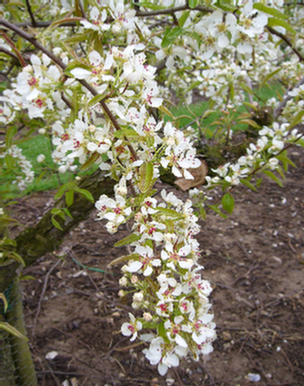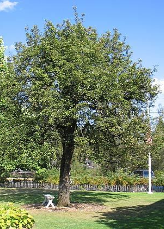

Winter Nelis is one of the best of the UK winter pears overall.
It is not a good looking pear but it certainly is a sweet one with lots of flavour, and it stores well
Rootstock: Our tree is grafted onto:
Pyrus c. rootstock (natural size)
giving a tree of 6m to 8m (20ft to 27ft) after seven years
Pruning:
This is a slow growing tree and pruning should be restricted in the first few years.
The flavour develops best when the tree is grown in a protected, sunny position.
Season: The main flowering time, in our area, will normally be the last week of April. Fruit will be ready for picking in the last week of October.
The fruit from Winter Nelis should be harvested when it is just under-
In practice, wait till a few pears drop off the tree of their own accord and then harvest the remainder over the next couple of weeks.
To ripen them fully, store at normal indoors temperature for two to three days. To store longer keep them in a cool dark place such as a garage, shed or the fridge. This variety has outstanding storage properties for a pear and can easily keep for a couple of months.
2. Winter Nelis - Desert Pear



Pollination:
Winter Nelis is self sterile and in pollination group D
It needs another tree in a similar group ( C, D or E) nearby in order to produce fruit.
Taken from an article by David Marks at www.gardenfocused.co.uk

Pyrus communis 'Winter Nelis'
Notes:
The Belgian city of Mechelen -
It was introduced to England in 1818, and rated by the Victorian fruit enthusiast Robert Hogg as "one of the richest flavoured pears".
The fruit is relatively small, roundish and narrowing abruptly towards the stalk.
The skin is dull green at first, changing to yellowish green and covered with numerous russetty patches, particularly on the side facing the sun .
The flesh is yellowish, fine-
The tree forms a handsome small pyramid, is quite hardy and an excellent bearer.